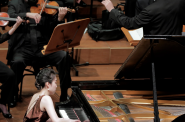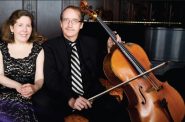Three Degrees of Separation
Chamber Music Milwaukee's performers have personal connections to works they'll play.
The Chamber Music Milwaukee series offers a variety of chamber music programs and players, drawing ensembles primarily from the Peck School of the Arts faculty at UW-Milwaukee. Because of the ever-shifting configurations, the series has not attracted the attention it deserves. Take this Thursday evening’s concert at UW-Milwaukee, which should be a special event.
The concert brings together Peck School faculty (cellist Stefan Kartman, violist Claudia Lasareff-Mironoff) and Milwaukee Symphony Orchestra clarinetist Todd Levy (who also teaches at Peck School), local chamber pianist Jeannie Yu and distinguished guests from Chicago chamber programs – violinists Reneé Paul Gautier and Sheila Walter.
The program will feature three masterpieces — by Béla Bartók, Sergei Rachmaninov and Johannes Brahms. Uniquely, each performance will be informed by the personal experiences — and historical lineage — each artist brings to the works.
Bartók was commissioned to write Contrasts for Violin, Clarinet, and Piano for Benny Goodman. Violinist Gautier and pianist Yu join clarinetist Todd in this virtuosic trio. The “contrasts” are in the changing rhythmic elements in the three movements. The music has been described as “an amalgam of abstracted Hungarian folk music combined with Rumanian dance melodies, Bulgarian and Greek meters, and a highly personalized, first-class command of 20th-century compositional techniques.” Levy points out that the music attempts to capture the rhythms of the Hungarian language. “Bartok tried to write out in Western notation how certain rhythms in the language went – which is almost impossible to do. People take freedoms with the music because they knew what he wanted.”
Levy learned the piece from Isidore Cohen, long the violinist with the Beaux Arts Trio, who had studied with Joseph Szigeti who had worked with Bartok and premiered Contrasts.
Rachmaninov’s Sonata for Piano and Cello in G minor, Op. 19, meanwhile, has special meaning for cellist Kartman and pianist Yu, who played the work together as students at Northwestern and many times since. Yu suggests that the sonata is like a virtuosic concerto for piano, but that with the “orchestra” represented by a cello, the piano must play softly and the cello is “constantly asked to chug out sounds.” Kartman observes that the sonata is “unapologetically romantic with grace and powerful long phrases.”
Kartman remembers learning the work from cellist Harvey Shapiro. The coda in the last movement is marked pianissimo, “but he came out with a huge sound and bit by bit nursed each one of those notes until they faded into nothing. (That was ) very effective, but not how it is written.” But Rachmaninov had decided after publication to change the approach. Shapiro learned the work from Willem Willeke, who had worked with Rachmaninov.
Kartman learned the work from his father, Myron Kartman who also taught Gautier and Yu at Northwestern. One of Myron Kartman’s teachers was a pupil of violinist Joseph Joachim – a friend and critical advisor to Brahms in the development of the Quintet. “One of the reasons my dad sent me to Julliard,” Kartman continued, “was so that I could have the experience” of learning from those with a lineage to these works. Julliard professor Shapiro was a student of a student of Joachim. At that time, Kartman wryly notes, “Julliard was the Jurassic Park of musicians.”
“In this piece,” Yu observes, “I am like the fifth member of the (string) group. I try to make my piano sound like a string instrument.” But Kartman notes that the articulation and volume in the piano part — as in the driving scherzo — cannot be matched by the strings. But in the slow movement, “I don’t think that anything could be more dramatic or dissonant without the strings. The strings shape every bit of the sound from one note to another.”
Context matters when interpreting a work. Violinist Gautier and Kartman played many times together while studying at Northwestern. Yu recalls playing the Quintet with the Kartman family (father, son, sister and brother as string quartet.) When you share a “similar pedagogical lineage,” Kartman muses, “when you do a rubato or phrasing, it’s as though they read your mind. You don’t have to discuss things.”
Thursday’s concert will serve to demonstrate the value of the “three degrees of separation” that brings these performers together to present true masterpieces of the chamber genre.
The concert begins at 7:30 p.m., February 18. The Chamber Music Milwaukee series is performed this year in the smaller, but acoustically excellent Music Recital Hall at 2400 E. Kenwood Blvd. (at the center of the Peck School of the Arts School complex.) General seating ticket prices are $10, students and under 18 – $5. Tickets may be purchased online at (414) 229-4308 or at the Box Office in the Peck School Theater building before the concert.
Preview
-
PianoArts Festival Features Rising Stars
 May 28th, 2024 by Michael Barndt
May 28th, 2024 by Michael Barndt
-
Four Nations Ensemble Goes For Baroque
 May 13th, 2024 by Michael Barndt
May 13th, 2024 by Michael Barndt
-
Mozart on Prospect Avenue
 May 9th, 2024 by Martha Brown
May 9th, 2024 by Martha Brown




















